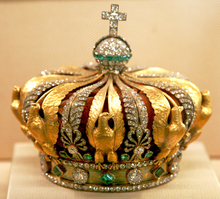Alexandre-Gabriel Lemonnier
Alexandre-Gabriel Lemonnier (born May 14, 1808 in Rouen , † July 16, 1884 in Paris ) was a French jeweler and purveyor to the court of Emperor Napoleon III.
life and work
Alexandre-Gabriel Lemonnier was born to Louis Augustin Lemonnier and his wife Thérèse Louise Antoinette, née Regnault, in 1808 in Rouen. He married Sophie Reymonde Duchâtenet (1822–1880) on August 25, 1846. There are two daughters from this marriage. Marguerite Louise, born in 1848, later married the publisher Georges Charpentier . She became an important patron of the Impressionist painters . The second daughter, Louise Charlotte Isabelle Lemonnier, was born in 1857. In her youth she was friends with the painter Édouard Manet , who created several portraits of her.
Alexandre-Gabriel Lemonnier began his professional career in the Bury jewelry store on Rue de Richelieu in Paris. His first own shop was at Place Vendôme No. 6. In 1853 he moved to new premises at Place Vendôme No. 25, where he initially lived with his family. Lemonnier established the Place Vendôme as the center of the important Parisian jewelers who have their shops in this place to this day. The family later lived at 35 rue du Quatre-Septembre. The family also owned a country estate in Gometz-le-Châtel .
Lemonnier's breakthrough as an internationally known jeweler came during the first world exhibition in London in 1851 . Here he received the Medal of the Council , the highest award in the exhibition, for two parures that he created for Queen Isabella II of Spain . After the world exhibition, the then French President Charles Louis Napoléon Bonaparte made him Knight of the Legion of Honor . After the Second Empire was proclaimed in 1852 , Napoleon III appointed him. 1853 to the imperial purveyor to the court.
Lemonnier received the first major order from the imperial family on the occasion of the wedding of Napoleon III. with Eugénie de Montijo in January 1853. On this occasion, Empress Eugénie wore a diadem made by Lemonnier and the jeweler François Kramer that she received from her husband as a wedding present. The diadem consists of 212 pearls and 1998 small diamonds that are set in silver. For this purpose, pearls from the jewelry of Empress Marie-Louise , Napoleon Bonaparte's second wife , were used. From then on, the diadem belonged to the French Crown Jewels and Empress Eugénie can be seen with this piece of jewelery on the official portrait of Franz Xaver Winterhalter from 1853. In 1887, the French state sold the tiara along with other crown jewels. In 1890 it came into the possession of the Thurn and Taxis family and was carried by Gloria von Thurn and Taxis when she married Johannes von Thurn and Taxis in 1980 . In 1992, Gloria von Thurn und Taxis sold the diadem for DM 935,000 to the Amis de Louvre ( Friends of the Louvre ). Since then it has been exhibited in the Louvre in Paris .
On the occasion of the Paris World Exhibition of 1855 , Napoleon III. Lemonnier commissioned two crowns for himself and his wife. While the emperor's crown is no longer preserved, the slightly smaller crown of the empress, made in the same style, testifies to the high level of craftsmanship of the jewelers involved. Eight golden brackets adorned with eagles stretch over a golden crown ring studded with precious stones. In between there are ornaments with palmettes made of diamonds . Above the temples there is a ball composed of diamonds with a circumferential band of emeralds. At the top there is a cross consisting of six diamonds . A total of 2,480 diamonds and 56 emeralds were used for the crown. While the crown itself was designed by Lemonnier together with J.-P. Maheu, the golden eagles on the crown come from the brothers Auguste and Joseph Fannière. The crowns of Napoleon III. and the empress were never used for a coronation. They were mainly used for representation during the World Exhibition of 1855. In 1875, the French state gave the Empress's crown to the exiled Eugénie, with whose family it remained until 1988. In the same year the Empress's crown came into the possession of the Louvre as a gift from Roberto Polo.
literature
- George H. Marcus (Ed.): The second Empire 1852-1870, art in france under Napoleon III . Philadelphia Museum of Art, Philadelphia 1978.
- Musée du Louvre (ed.): Nouvelles acquisitions du Département des objects d'art 1985-1889 . Réunion des musées nationaux, Paris 1990, ISBN 2-7118-2365-2 .
- Adrien Goetz, Claudette Joannis: Jewels in the Louvre . Musée de Louvre Éditions, Paris 2008, ISBN 978-2-35031-194-4 .
- Alison McQueen: Empress Eugénie and the Arts, Politics and Visual Culture in the Nineteenth Century . Ashgate, Farnham 2011, ISBN 978-1-4094-0585-6 .
Web links
| personal data | |
|---|---|
| SURNAME | Lemonnier, Alexandre-Gabriel |
| BRIEF DESCRIPTION | French jeweler |
| DATE OF BIRTH | May 14, 1808 |
| PLACE OF BIRTH | Rouen |
| DATE OF DEATH | July 16, 1884 |
| Place of death | Paris |


